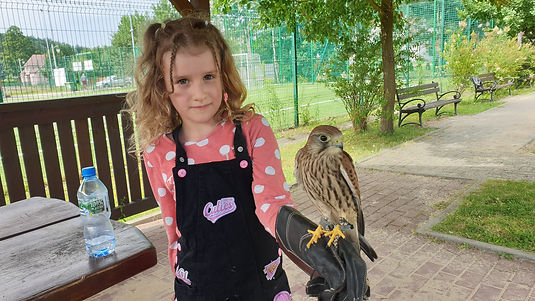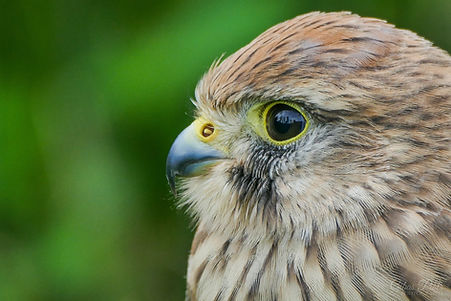Stockton the European Kestrel
Stockton is a juvenile male Kestrel. He currently has a brown head which will change to a beautiful grey-blue in the coming years. He is a popular small falcon which likes attention on the glove and posing for photos with children and also enjoys professional photo-shoots from time to time.
This small falcon costs approximately 40zl per month to feed and care for, by sponsoring him you provide enough food for a month. 65zl covers food + vitamin supplements, 90zl covers everything we need to give him a comfortable life.





European Kestrel (Falco tinnunculus)
Appearance
The Kestrel is a small falcon with distinctive male plumage: grey head, rusty back, grey tail with broad black tip. The female is brownish above, with barring on the back, wings, and tail. They have rather pointed wingtips (unlike the rounded broader wings of hawks), and distinct dark spotting on the breast. Very similar to Lesser Kestrel.
Our bird is a male Kestrel, however as he still has his juvenile plumage, his grey head feathers haven't yet appeared so he looks like a mature female kestrel.
Food
The kestrel is a vole specialist, with the field vole accounting for the majority of its diet. It will also take mice and shrews, as well as small birds and occasionally worms and insects. Birds are taken more often in places where voles are scarce, such as in urban areas.
Our Kestrels in captivity are offered a variety of foods consisting of both birds and rodents in order to give them a balanced diet.
Habitat
Inhabits open and lightly wooded country, farmlands, grasslands, and heathlands; often seen over grassy areas beside roads and at airports. The Kestrel perches on wires and posts, and typically hunts by hovering, at times fairly high overhead.
How long do Kestrels live?
Most wild kestrels die before they reach 2 years of age; mortality up until the first years end may be as high as 70%. Like Barn Owls this is usually due to the harsh cold winters when their food supply decreases or through poisoning of their food source by chemicals used in the farming industry. At least females generally breed at one year of age; possibly, some males take a year longer to reach maturity as they do in related species. In captivity they can live much longer (over 15 years) due to the special care and attention we give them.
By donating you...
Help us to educate people in more detail than above with public visits with our birds.
You are helping to protect the future of these birds in the wild as we raise awareness of ways to help their wild populations through conservation.
Please remember that Kestrels do not make good pets for inexperienced keepers. They require lots of studying, upkeep costs and correct housing on top of the daily care and attention to allow them a life as close to that of their wild populations as possible.
